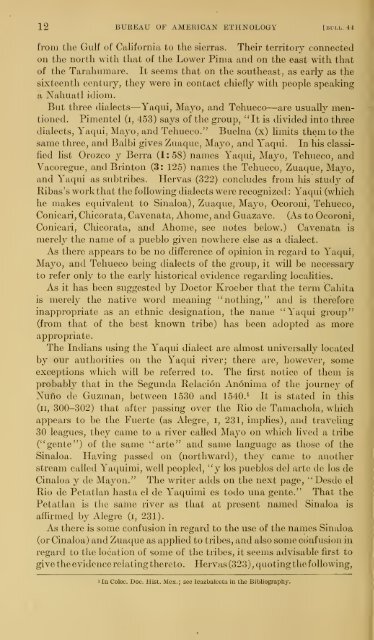Untitled - Smithsonian Institution
Untitled - Smithsonian Institution
Untitled - Smithsonian Institution
You also want an ePaper? Increase the reach of your titles
YUMPU automatically turns print PDFs into web optimized ePapers that Google loves.
12 BUREAU OF AMERICAN ETHNOLOGY [bull. 44<br />
from the Gulf of California to the sierras. Their territory connected<br />
on the north with that of the Lower Pima and on the east with that<br />
of the Tarahumare. It seems that on the southeast, as early as the<br />
sixteenth century, they were in contact chiefly with people speaking<br />
a Nahuatl idiom.<br />
But three dialects—Yaqui, Mayo, and Tehueco—are usually men-<br />
tioned. Pimentel (i, 453) says of the group, "It is divided into three<br />
dialects, Yaqui, Mayo, and Tehueco." Buelna (x) hmits them to the<br />
same three, and Balbi gives Zuaque, Mayo, and Yaqui. In his classified<br />
list Orozco y Berra (1:58) names Yaqui, Mayo, Tehueco, and<br />
Vacoregue, and Brinton (3: 125) names the Tehueco, Zuaque, Mayo,<br />
and Yaqui as subtribes. Hervas (322) concludes from his stud}^ of<br />
Ribas's work that the following dialects were recognized : Yaqui (which<br />
he makes equivalent to Sinaloa), Zuaque, Mayo, Ocoroni, Tehueco,<br />
Conicari, Chicorata, Cavenata, Ahome, and Guazave. (As to Ocoroni,<br />
Conicari, Chicorata, and Ahome, see notes below.) Cavenata is<br />
merely the name of a pueblo given nowhere else as a dialect.<br />
As there appears to be no difference of opinion in regard to Yaqui,<br />
Mayo, and Tehueco being dialects of the group, it will be necessary<br />
to refer only to the early historical evidence regarding locahties.<br />
As it has been suggested by Doctor Kroeber that the term Cahita<br />
is merely the native word meaning ''nothing," and is therefore<br />
inappropriate as an ethnic designation, the name "Yaqui group"<br />
(from that of the best known tribe) has been adopted as more<br />
appropriate.<br />
The Indians using the Yaqui dialect are almost universally located<br />
by our authorities on the Yaqui river; there are, however, some<br />
exceptions which will be referred to. The first notice of them is<br />
probably that in the Segunda Relacion Anonima of the journey of<br />
Nuno de Guzman, between 1530 and 1540.^ It is stated in this<br />
(ii, 300-302) that after passing over the Rio de Tamachola, wliich<br />
appears to be the Fuerte (as Alegre, i, 231, impUes), and travehng<br />
30 leagues, they came to a river called Mayo on which hved a tribe<br />
("gente") of the same "arte" and same language as those of the<br />
Sinaloa. Having passed on (northward), they came to another<br />
stream called Yaquimi, well peopled, "y los pueblos del arte de los de<br />
Cinaloa y de Mayon." The writer adds on the next page, "Desde el<br />
Rio de Petatlan hasta el de Yaquimi es todo una gente." That the<br />
Petatlan is the same river as that at present named Sinaloa is<br />
affirmed by Alegre (i, 231).<br />
As there is some confusion in regard to the use of the names Sinaloa<br />
(or Cinaloa) and Zuaque as appUed to tribes, and also some confusion in<br />
regard to the location of some of the tribes, it seems advisable first to<br />
give the evidence relating thereto. Hervas (323) , quoting the following,<br />
1 In Colec. Doc. Hist. Mex. ; see Icazbalceta iu the Bibliography.

















